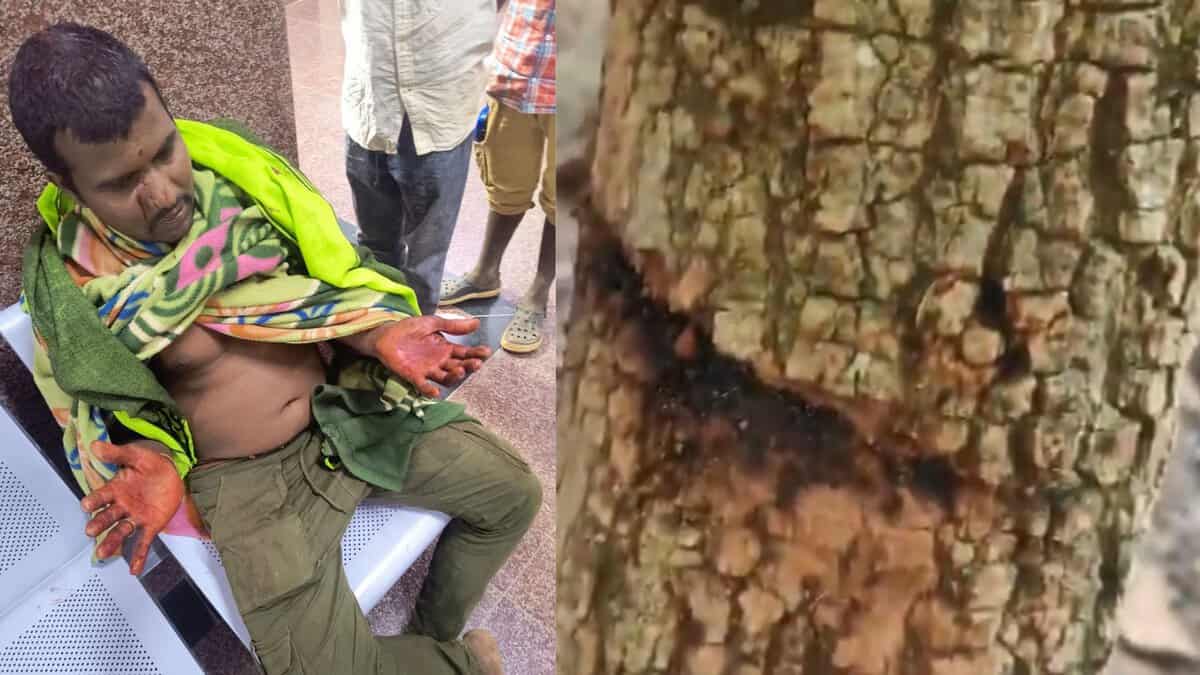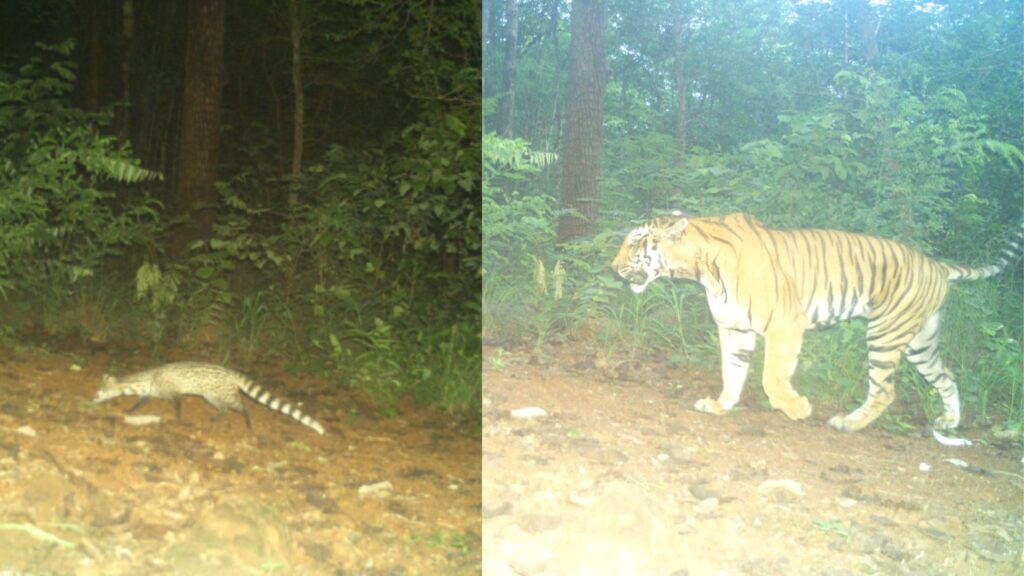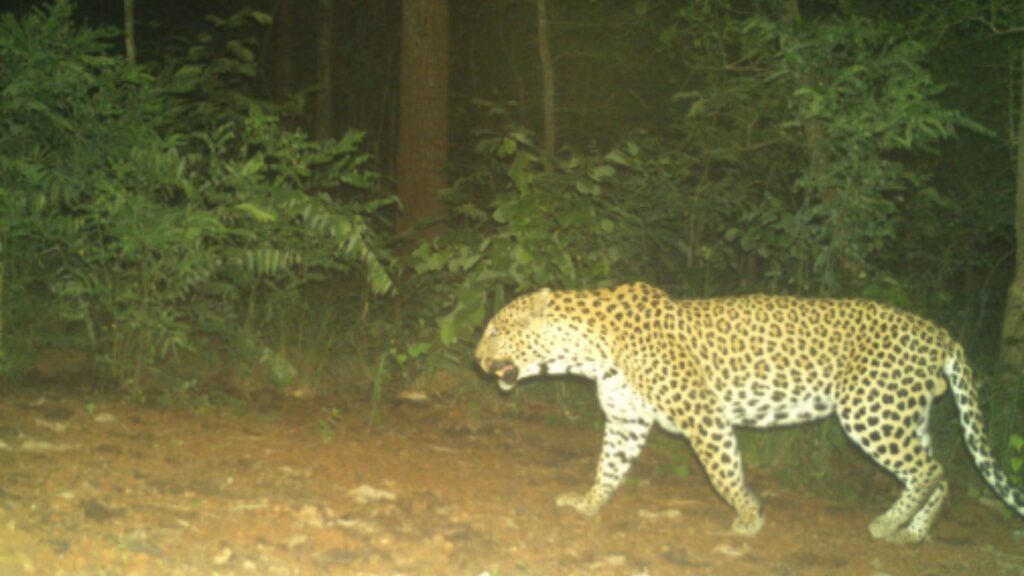
Hyderabad: The picture of a Small Indian Civet lying in a pool of blood after being mowed down by an unidentified vehicle on Srisailam Highway (NH-765) inside the Amrabad Tiger Reserve (Nallamala forest in Telangana), was posted by the forest officials on September 5.
“Over-speeding kills. Forests are their home, not our highways. Respect the 30 km/hr speed limit — your patience can save a life,” the Amrabad Tiger Reserve’s official X handle appealed to the people.
But more gruesome and merciless killing is happening deep inside the core forest area, where the wild animals are being trapped, strangulated, killed and sold for a high price as far as Hyderabad. Unfortunately, the perpetrators of the crime are believed to be members of the Chenchu tribe, who according to authorities are doing it for greed. They are also supported by a well-organised network of wildlife poachers.
The Amrabad Tiger Reserve (ATR) reopened on October 1, after the wildlife safari was closed for three months during the monsoons, when wild animals mate, including tigers. It was during this period when the wild animals were allegedly hunted using traps, which was exposed by Thokala Ravi, a tiger-tracker who also belongs to the Chenchu tribe.

On September 8, Ravi had found the traps laid in the woods leading to a pond located inside Pullaipally hamlet of Appapur gram panchayat. The traps were apparently laid to trap big wild animals like a deer, stag, Nilgai and other wild animals whose meat is high in demand.
Clutch cables were tied between the trees in the path taken by the wild animals to reach the water body.
“When the head of an animal gets trapped in the cables, it tries to free itself, but in the process it gets entangled in the cables, and gets strangulated to death. The animal struggles a lot before dying,” Ravi told Siasat.com.
When Ravi seized the traps, Nimmala Lingaswamy and Nimmala Chinna Bala Guruvaiah, both residents of Rampur Penta, and Lingaswamy, a resident of Balmoor, had an argument with him. They demanded him the return their traps to them. Ravi not only refused to do so, but also informed the forest officials how wild life hunting was happening inside the core forest area. he also handed over the traps to the forest officials.
It is important to note that Nimmala Lingaswamy also works as a tiger-tracker in Agarlapenta, which is another hamlet, whose base camp was recently merged with Pullaipally.
The very night, the three individuals came to his house and attacked him with sticks, broke his cell phone, and in Ravi’s words, tried to kill him. Ravi sustained a head injury in the attack. As his mother and younger brother came out of their hut, the three attackers fled. Fearing for his life, Ravi fled the forest and got admitted to Achampet Government Hospital, where he received treatment till the end of September.

“I questioned them how they could kill the wild animals, which are the source of our livelihood,” Ravi recalls his interaction with his adversaries on the day of the attack.
Though both the sides filed cases against each other in Lingal police station with regard to the attack on September 8, till now no case has been booked against those responsible for poaching wild animals for their meat by the forest department. Ravi could be seen in videos showing cuts on the trunk of the trees caused by the wires, which indicates that wild animals were indeed trapped by poachers.
Ravi has been working as a tiger tracker since 2020 in a contractual role, presently getting a take home pay of around Rs 10,000 per month (after deductions). He used to make around Rs 5,000 when he started working for the department.
According to local sources, there are multiple ways through which poachers were illegally transporting wild life meat from forests of Telangana. One route is from Agarlapenta, which leads to Lingal, the mandal headquarter, from where a supply-chain network transports them as far as Hyderabad.
There is another route taken by the poachers through the Krishna River using boats, which helps them to transport the meat to Srisailam and other parts of Andhra Pradesh. “The wildlife meat is high in demand and is highly remunerative. The poachers know that the movement of wild animals is high during their mating season,” Ravi points out.
It needs to be mentioned here, that Chenchus don’t hunt wild animals, but only recover the meat left-over by the predator after killing and eating it’s prey.
According to local sources, the forest officials are just ignoring the poaching incident, as it involves Chenchus from different clans, serving in the forest department as tiger trackers.
It is also a little-known fact that the Thokala and Nimmala clans have been at the loggerheads since the olden days. Though being two different clans, there have been marriages and between the two communities, and also killings in the past.
Clashes between two groups, can’t vitiate the atmosphere: DFO
Nagarkurnool District Forest Officer and Integrated Tribal Development Agency (ITDA) Mannanur Project Officer Rohith Gopidi acknowledged that there have been clashes between the two Chenchu groups, with Appapur and Pullaipally hamlets being on one side, and Rampur on the other.
“Any mis-discretion on our side will further vitiate the atmosphere there,” Rohith cautioned, also informing that the snares (traps) were taken from Ravi’s home, and that according to Ravi, they were recovered by him from the field without informing the forest staff.
Mannanur Forest Range Officer (FRO) Nalla Veeresh too said that there was no clear evidence as to who laid the traps, whether it was Ravi, or his adversaries.
“Forest watcher Thokala Ravi initially informed us about the presence of traps in the area, but did not show them to us directly. Despite several visits by myself and our field staff, no traps were found at the location. Later, Ravi himself brought some traps and handed them over to us,” the FRO stated.
He also stated that his team once again inspected the site thoroughly, but couldn’t find any evidence of hunting or other illegal activity.
“So far, there has been no history of such incidents in this location,” he claimed.
“We also interrogated Linga Swamy, against whom allegations were made, along with a few others, but no clear facts regarding the traps could be established. Our inquiry indicates that there are strong personal grudges and disputes behind this issue. It also appears that Ravi may have planted the traps himself to falsely implicate Linga Swamy, who organises the Saleshwaram Jatara,” Veeresham claimed.
He also recalled both the parties being involved in physical clashes, and that they filed cases against each other at the Lingal police station in the past, right after the conclusion of the Saleshwaram Jatara held in April 2025.
He also mentioned that the differences between the two clans which began during the Saleshwaram Jatara, have been snowballing into more issues.
“We can’t use force against either of the sides, as they are related families. We are being very cautious and have been giving counseling to the aggrieved parties to ease the tensions between them,” Veeresham told Siasat.com.
“A full inquiry is underway, and once the culprits are identified, they will be booked under relevant provisions of the Forest Acts and produced before the court,” he assured Siasat.com.
“Thank you for your support In conservation of mother Nature,” his department’s rejoinder to Siasat.com on Friday, October 3, 2025- concluded stating so.




